Welcome to my first module! 🙂
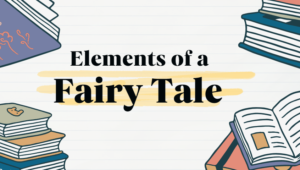
I actually had a ton of fun bringing this module to life over the past couple of weeks. From the initial planning with the ADDIE model to creating educational content on Lumi, I am enjoying the process so far! As I am sure we can all agree, learning something new is challenging but ultimately rewarding; my experience with Lumi (so far) has been just that.
Lumi experience:
I will admit, it took me a minute (ok…an hour) to get the hang of the interactions (so many options!) and decide what would work best for my learners. Once I explored the vast menu of interactions and experienced (lots of) trial and error, I felt more at ease. Also, the site has a lot of free informative material available, which was super helpful!
For my interactive Lumi lesson, I chose a short YouTube video introducing the basic elements of a fairy tale. Typically, I use this brief video (1:19) in class to begin my fairy tale unit. In past years, I have played this video twice, sometimes three times, for students so they can actually digest the quick, new content. As well, I would always stop the video multiple times to discuss the information being presented. Transforming this video into an interactive media is a game changer! The interactive elements allowed me to (in a way) mimic, or perhaps enhance, the typical in class discussion/interaction, for students to engage with the content independently during this online module.
You may notice the frequency of the added interactions in my Lumi video. To best engage my young learners, I added interactive elements often. This will help students stay focused on the content and allows me to formatively assess their understanding throughout. I primarily used multiple choice, open ended and true/false questions. My goal was to keep the questions short and simple to ensure my learners could complete them independently and successfully. At the end, I included a fill in the blanks and a summary activity.
Some closing thoughts on Lumi (with my minimal experience)
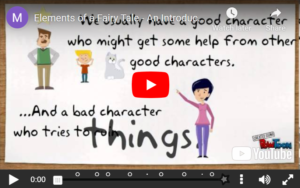
- Learning Lumi is overwhelming (I can’t be alone on this?)
- Very time-consuming to start (HOURS spent on a 1 minute video)
- Eventually, Lumi is quite user friendly
- The finished product is very satisfying
- Formatting and editing interactions is TEDIOUS
- Interactive elements can serve as quick assessment
- Interactivity KEY for online learning
- Free version is sufficient
- Endless possibilities with paid subscription
Module One (so far…) Summary:
I have begun the ‘shell’ for my first blended learning module on Seesaw, the LMS I’ve selected. Using the Seesaw ACTIVITY feature, I explain each step for Module One: Fairy Tales Elements. The learning activities are explained on each page of the Module One Seesaw activity. See linked activity below: there are 10 pages that will take students through this module. Learners will complete work right in Seesaw, in this specific activity. They will access video links (Lumi instruction and YouTube read alouds), record their learning (using microphone and writing tools on Seesaw), and complete assessment tasks (during Lumi video and in Seesaw). I used Canva to help create visuals for my Seesaw activities, as Seesaw is quite limited in design and formatting options.
*Module 1: Fairy Tales Elements (link to module one on Seesaw)
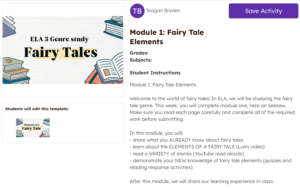

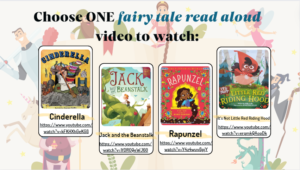
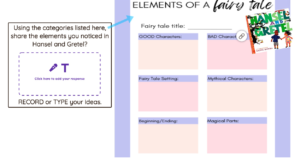
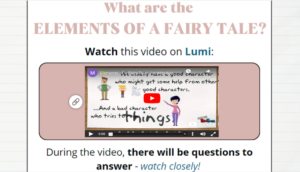
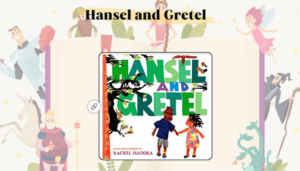
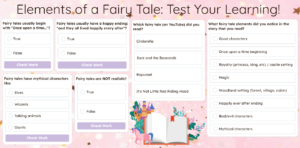

Assessment of Module One:
Diagnostic – During class (in person), we discuss students’ prior knowledge via partner, small group and then whole class discussion. Students will consider what they already know about this genre and brainstorm stories they are familiar with. In Module One, on page two of the Seesaw activity, students share what they know about fairy tales already. As well, in the Lumi video, students share what fairy tales they already know. Answers from in-class discussions, Seesaw and Lumi will help guide my instruction moving forward.
Formative – The interactions in my Lumi lesson and the activities in the Seesaw module will serve as formative assessment.
In Lumi, students will answer various questions, throughout the video, to display their understanding of the elements of a fairy tale that are being introduced. *Without a paid Lumi subscription, I can’t access the results. To check-in on student learning, I will ask them to either show me their results (in person) or have them upload a photo of them to Seesaw. Based on the results of these interactive questions, I will, if needed, either re-assign this video for students to view again and/or provide further in class instruction on these elements.
In Seesaw, there are three pages that require students to demonstrate their learning of fairy tale elements so far. They will answer questions and explain their learning through verbal or written responses.
Summative – Summative assessment will take place later on during this blended unit.
Links:
- Original YouTube video: https://www.youtube.com/watch?v=E6asEc6nsOQ
- Lumi interactive video: https://app.Lumi.education/run/gcSzxK
- Fairy tale read alouds: Linked in Seesaw activity
- Seesaw activity: https://app.seesaw.me/pages/shared_activity?prompt_id=prompt.8e79df50-d32d-4601-8890-dc71d83877a1&share_token=teyfap7tRfyTlQ_CKQzOvw
This module remains a work in progress. Feedback (especially on my Lumi video) is much appreciated! Also, I am interested in everyone else’s Lumi experience? Anyone else have a kind of love/hate opinion of this program?
– Teagan
2 Comments
Arkin
Teagan, I can totally relate to your post as I feel the same about my Lumi experience. The many options were overwhelming at times, and I still feel that I have so much more to explore to fully understand the capabilities. I found it to be very student-friendly and can meet the needs of many students, but does take some time to become efficient enough with this program to complete a lesson in a manageable amount of time, However, like anything, it does become easier, and in the end, Lumi is a valuable tool for blended learning purposes.
Lauren Bradshaw
Your module has a great combination of in-person activities, collaborations between students, and online interactive activities. Well done! I think it will keep your students engaged and help them meet learning objectives.
My Lumi thoughts are similar to yours, although I ended up buying a subscription as I was having some technical difficulties. Now that I’ve used it a few times, I can see myself using it a lot in the future. Safety training is usually just text/power-points with no videos, interactions, or games at all. Lumi can certainly add a bit of variety to keep everyone engaged (hopefully).